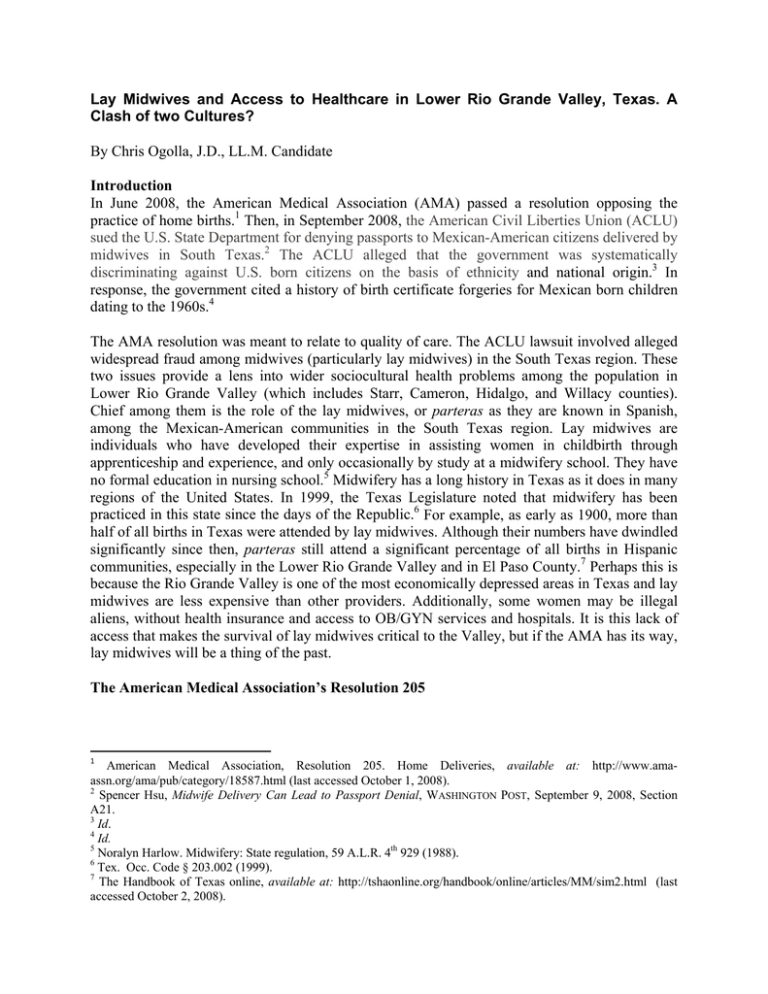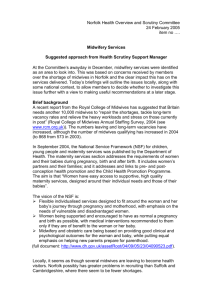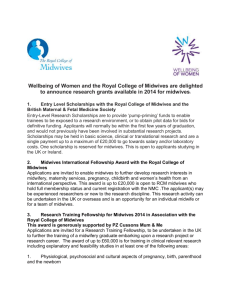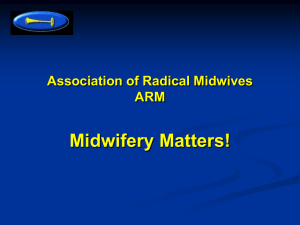Lay Midwives and Access to Healthcare in Lower Rio Grande... Clash of two Cultures? Introduction
advertisement

Lay Midwives and Access to Healthcare in Lower Rio Grande Valley, Texas. A Clash of two Cultures? By Chris Ogolla, J.D., LL.M. Candidate Introduction In June 2008, the American Medical Association (AMA) passed a resolution opposing the practice of home births.1 Then, in September 2008, the American Civil Liberties Union (ACLU) sued the U.S. State Department for denying passports to Mexican-American citizens delivered by midwives in South Texas.2 The ACLU alleged that the government was systematically discriminating against U.S. born citizens on the basis of ethnicity and national origin.3 In response, the government cited a history of birth certificate forgeries for Mexican born children dating to the 1960s.4 The AMA resolution was meant to relate to quality of care. The ACLU lawsuit involved alleged widespread fraud among midwives (particularly lay midwives) in the South Texas region. These two issues provide a lens into wider sociocultural health problems among the population in Lower Rio Grande Valley (which includes Starr, Cameron, Hidalgo, and Willacy counties). Chief among them is the role of the lay midwives, or parteras as they are known in Spanish, among the Mexican-American communities in the South Texas region. Lay midwives are individuals who have developed their expertise in assisting women in childbirth through apprenticeship and experience, and only occasionally by study at a midwifery school. They have no formal education in nursing school.5 Midwifery has a long history in Texas as it does in many regions of the United States. In 1999, the Texas Legislature noted that midwifery has been practiced in this state since the days of the Republic.6 For example, as early as 1900, more than half of all births in Texas were attended by lay midwives. Although their numbers have dwindled significantly since then, parteras still attend a significant percentage of all births in Hispanic communities, especially in the Lower Rio Grande Valley and in El Paso County.7 Perhaps this is because the Rio Grande Valley is one of the most economically depressed areas in Texas and lay midwives are less expensive than other providers. Additionally, some women may be illegal aliens, without health insurance and access to OB/GYN services and hospitals. It is this lack of access that makes the survival of lay midwives critical to the Valley, but if the AMA has its way, lay midwives will be a thing of the past. The American Medical Association’s Resolution 205 1 American Medical Association, Resolution 205. Home Deliveries, available at: http://www.amaassn.org/ama/pub/category/18587.html (last accessed October 1, 2008). 2 Spencer Hsu, Midwife Delivery Can Lead to Passport Denial, WASHINGTON POST, September 9, 2008, Section A21. 3 Id. 4 Id. 5 Noralyn Harlow. Midwifery: State regulation, 59 A.L.R. 4th 929 (1988). 6 Tex. Occ. Code § 203.002 (1999). 7 The Handbook of Texas online, available at: http://tshaonline.org/handbook/online/articles/MM/sim2.html (last accessed October 2, 2008). The AMA recently issued Resolution 205 calling on lawmakers to oppose the home birthing practice. The resolution was passed in response to a bill filed in the Massachusetts Senate.8 The bill would establish a separate “Board of Registration in Midwifery” with expanded scope of practice and with educational requirements for licensure being left to the discretion of membership organizations.9 The AMA resolved to advocate in legislative and regulatory arenas for only licensing midwives who are certified by the American College of Nurse Midwives and to develop model legislation regarding appropriate physician and regulatory oversight of midwifery practice, under the jurisdiction of either state nursing or medical boards.10 There are three problems with this resolution. First, the AMA excludes lay midwives. Second, in areas like the Rio Grande Valley where access to healthcare is one of the biggest problems, it would be unrealistic to limit birth attendants to only those certified by the American College of Nurse Midwives. Third, the states already properly regulate midwifery. Regulation According to the Texas Department of State Health Services, historically acts of the legislature regarding such public health practices as eye care at birth, registration of birth, detection of sexually transmitted disease, and newborn screening for phenylketonuria or diabetes, have recognized midwives as practitioners. Yet prior to 1983, Texas did not regulate midwives. In 1983 the Texas Legislature passed the Texas Midwifery Act because of rising concerns among legislators over the lack of regulation of direct entry midwives.11 The Act defined midwifery as the practice of: (a) providing the necessary supervision, care, and advice to a woman during normal pregnancy, labor, and the postpartum period; (b) conducting a normal delivery of a child; and (c) providing normal newborn care.12 The Act prohibited unlicensed midwives from practice. Likely impact of AMA Resolution on lay midwives in the Valley The Lower Rio Grande Valley is one of the most economically depressed areas in Texas. As of January 2007, the Texas State Data Center and Office of State Demographer estimated the population of the Valley as approximately 1,139,581. According to the Migrant Health Promotion Organization, nearly 90 percent of the Valley population is Hispanic. The Valley is the permanent home of one of the largest concentrations of farm workers in the United States; roughly one third of its population depends on employment in agriculture.13 One common feature in the Valley are Colonias or groups of homes that used to be fields. The Texas Secretary of State in 2004 noted that Colonias are full of public health issues including dilapidated homes, a lack of potable water, sewer, and drainage systems. Texas Department State Health Services data show that hepatitis A, salmonellosis, dysentery, cholera and other diseases occur at much higher rates in Colonias than in Texas as a whole. Tuberculosis is also a common health threat, occurring almost twice as frequently along the border than in Texas as a whole. A lack of medical services compounds health problems in the Colonias. In addition to a shortage of primary care providers, Colonia residents' difficulty in accessing health care is compounded by 8 Resolution 205, supra note 1. Id. 10 Id. 11 Texas Department of State Health Services. Texas Midwifery Board. About the Profession. History in Texas, available at http://www.dshs.state.tx.us/midwife/mw_history.shtm (last accessed October 3, 2008). 12 Tex. Occ. Code § 203.003 (1999). 13 See Migrant Health Promotion. The Lower Rio Grande Valley, available at: http://www.migranthealth.org/farmworker_communities/rio_grande_valley.php (last accessed September 28, 2008). 9 having to travel long distances to health care facilities, fear of losing wages for time spent away from work, inconvenient health care facility hours, lack of awareness of available health care programs and no health insurance.14 One can therefore appreciate the role of lay midwives in such an environment. The Brownsville Herald noted that for decades along the border midwifery was utilized as an alternative to expensive hospitals visits. To many, the Valley’s lay midwives are considered more than purveyors of a practical service.15 The lay midwives play the roles of lay minister, godmother, foster mother, interpreter/translator and caretaker.16 This is in sharp contrast to modern day certified nurse midwives (CNMs) whose primary function is to deliver babies according to standard medical protocols. CNMs are given wide latitudes in their practice; for example, they may have prescriptive authority delegated by physicians. Moreover, they are regulated by the Board of Nurse Examiners, unlike lay midwives. So why the disparity between the two groups? A clash of two cultures Apart from the difference in education and training between the certified CNMs and lay midwives, there is also the clash of the culture of conventional allopathic medicine, represented by the AMA, versus complementary and alternative medicine, represented by lay midwives. It is a clash between hospital-based birth and home birth. Stripped to its essential elements, this is an economic distinction between those with access to hospital services and those without. If the AMA succeeds in eliminating lay midwives, it will have eliminated the only reliable access to care for many disadvantaged pregnant women and their children. While there is clearly an educational difference between CNMs and lay midwives, even the AMA should agree that prenatal care and perinatal care from a lay midwife is better than no care at all, which is likely what many Valley would receive without lay midwives. The AMA does not cite any scientific evidence to support claims that lay midwives are inherently unsafe, and a growing number of states license or credential both professional and lay midwives, thereby ensuring adequate standards. Recent media attention focused on home births seems to support the notion that some women want a home birth versus hospital birth.17 An ideal solution would be to build hospitals in the Valley where each mother would have access to both prenatal and post-natal care. But this is not a perfect world. In places like the Valley, lay midwives were delivering babies long before the State passed the Midwifery Act in 1983 or the AMA thought of even opposing home births. For these reasons, lay midwives should be accepted where there is a critical need for them. Without lay midwives, many women in the Valley would go without care. This is clearly the wrong answer from a public health standpoint, and Texas should continue to support lay midwives in the Valley and other areas where they are needed. 14 Texas Secretary of State Jeffrey S. Connor. (n.d.). Colonias frequently asked question, available at: http://www.sos.state.tx.us/border/colonias/faqs.shtml (last accessed September 28, 2008). 15 Kevin Seiff, Midwives Struggle against new fears and horror stories among patients. The BROWNSVILLE HERALD August 23, 2008. 16 Manocchio RT. Tending Communities, Crossing cultures: Midwives in the 19th-Century California. J. Midwifery Womens Health;53 (1):75-81(2008). 17 ACNM responds to AMA Resolutions on Homebirth and Physician Oversight of Midwives, available at: http://www.acnm.org/ACNM_Response_to_AMA.cfm (last accessed October 7, 2008). The American College of Nurse Midwives asserted its strong support for a woman’s right to choose her site of birth and voiced strong opposition to AMA’s call for greater physician oversight in midwifery. Health Law Perspectives (November 2008), available at: http://www.law.uh.edu/healthlaw/perspectives/homepage.asp

![Letter to MPs re: maternal mental health report Dear [Name of MP] I](http://s3.studylib.net/store/data/006839335_1-7d7b3127aade7ad6d126565942ce75c1-300x300.png)



